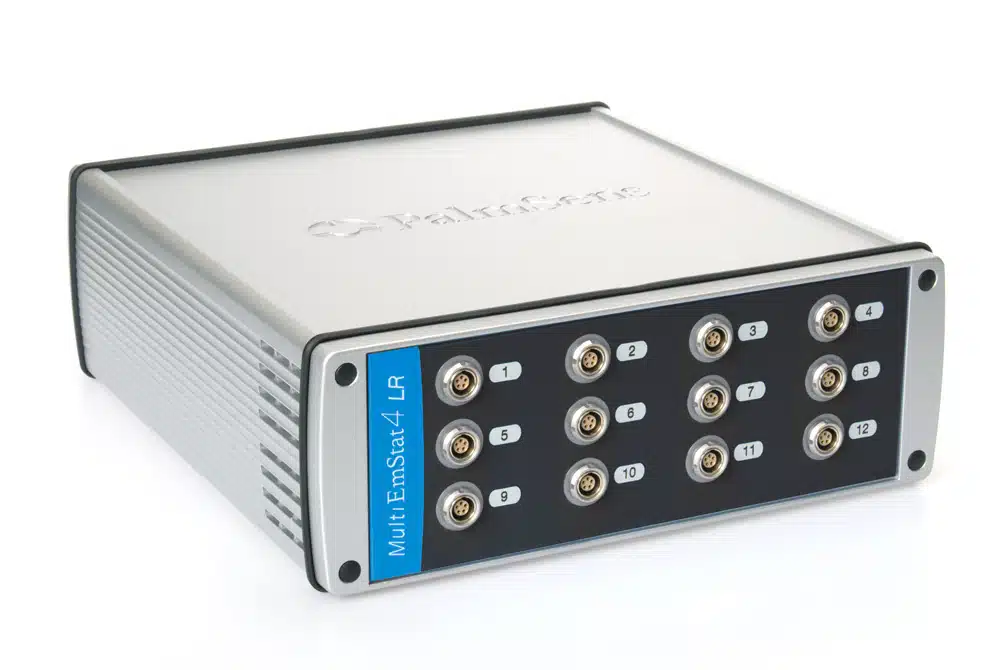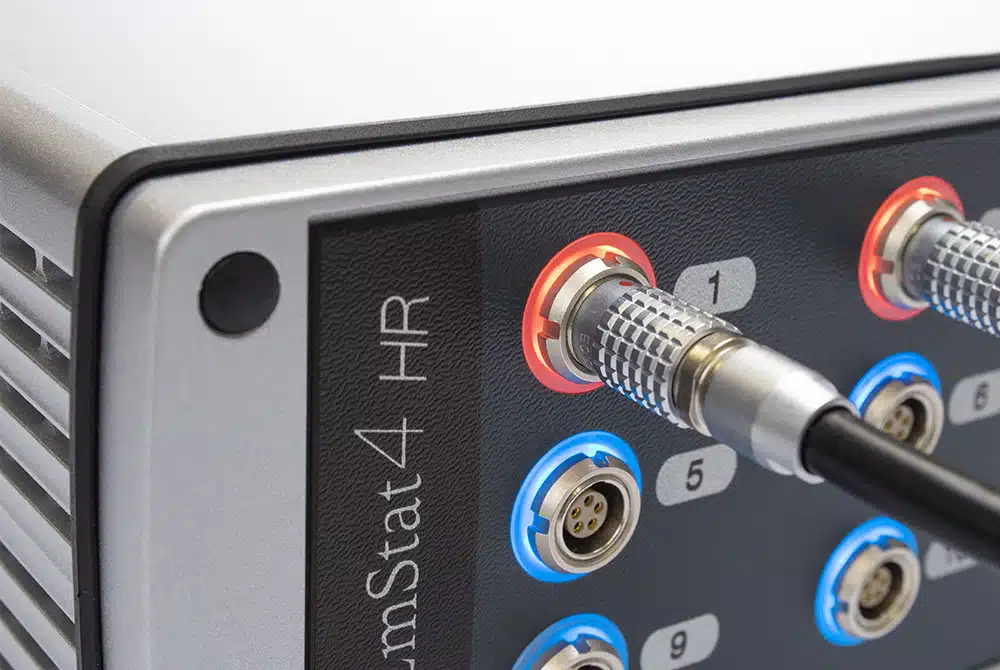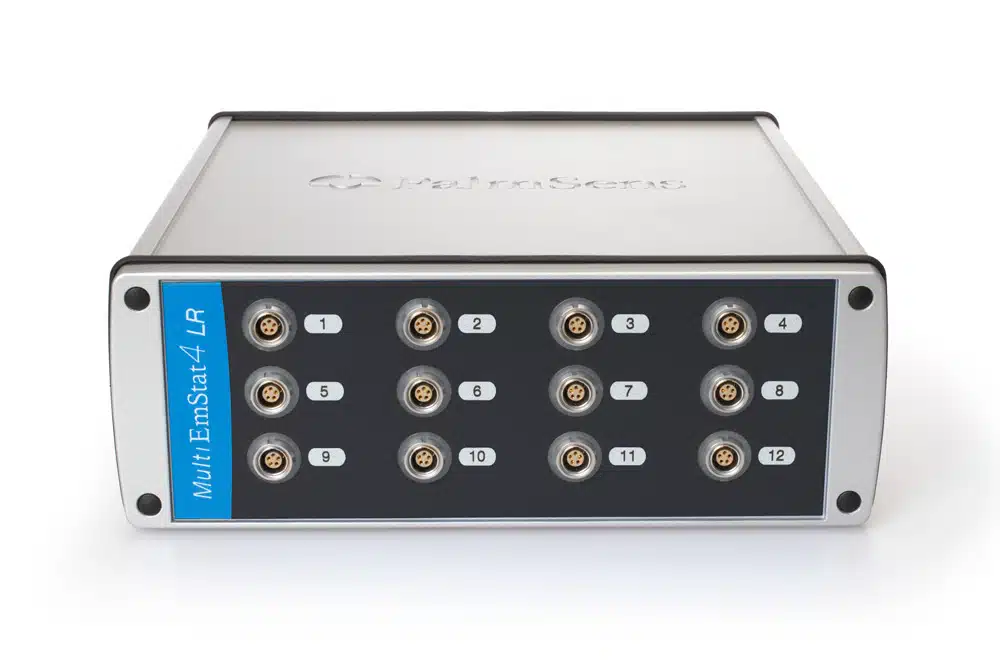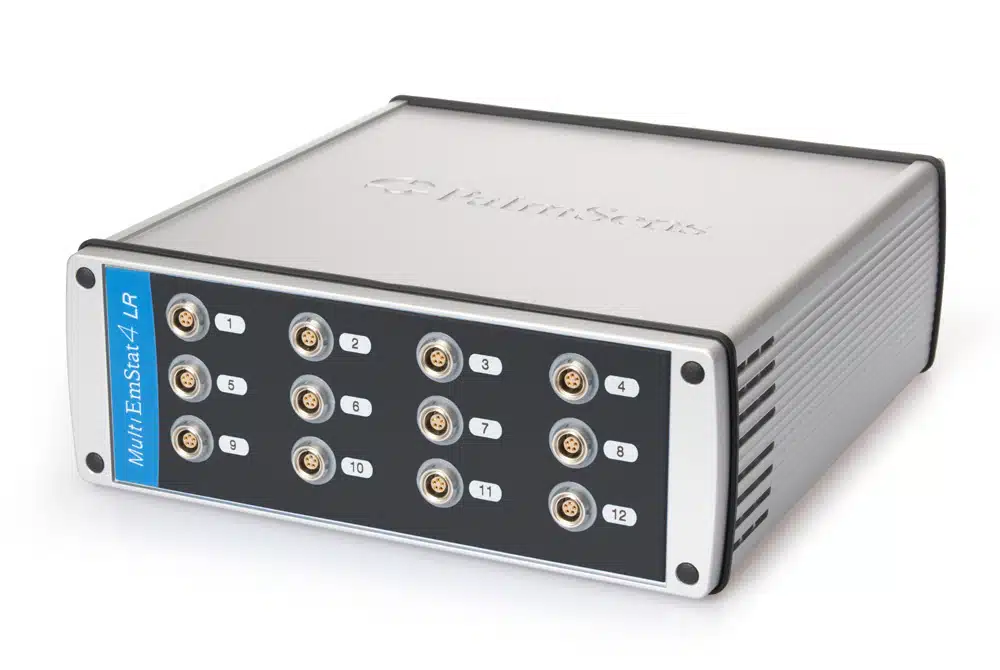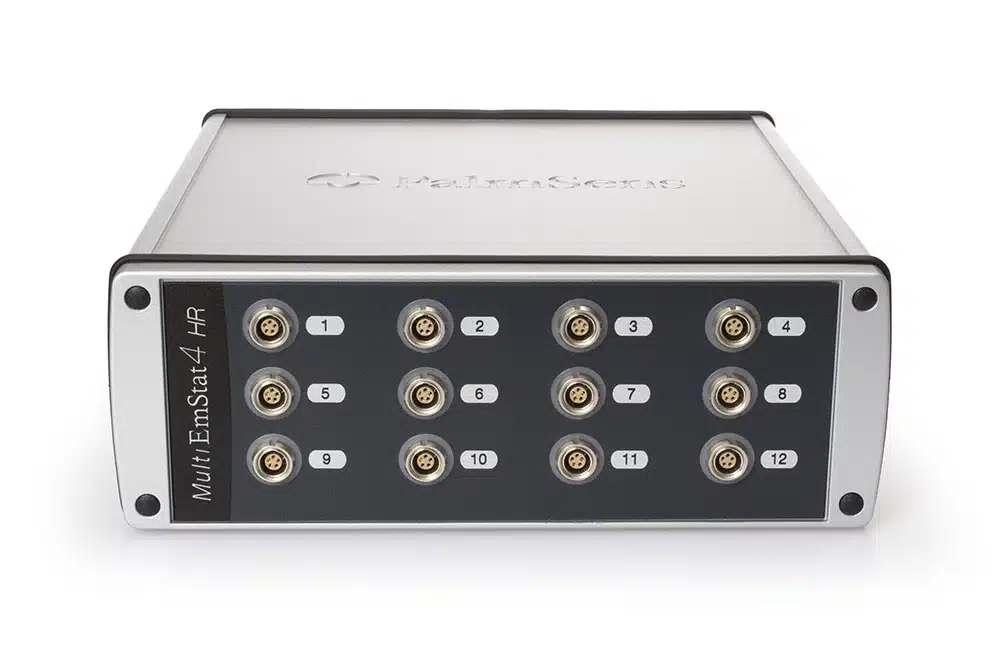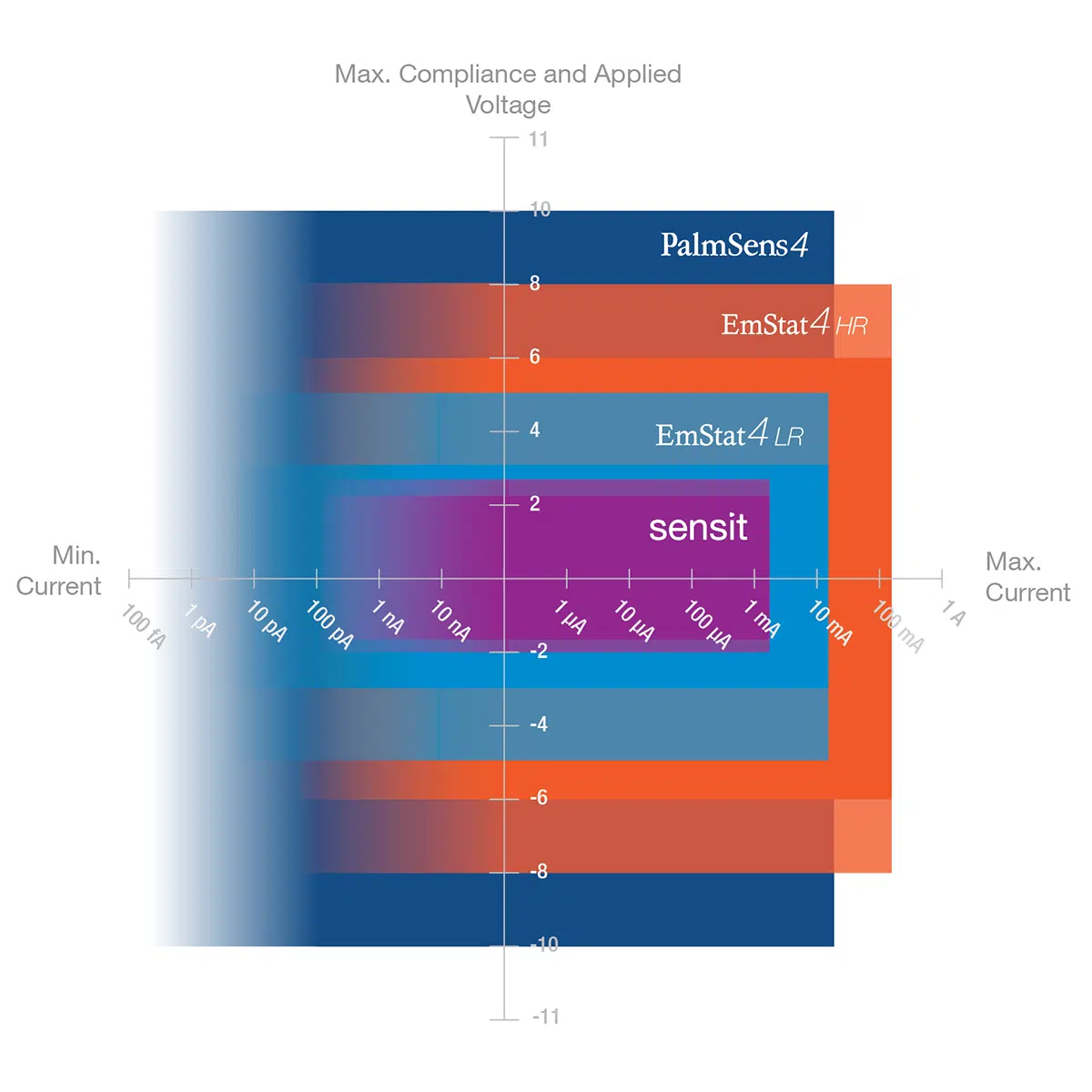MultiEmStat4
Multi-channel Potentiostat / Galvanostat / Impedance Analyzer
- Available with 4, 8 or 12 channels
- FRA / EIS: 10 μHz up to 200 kHz
- Potential range: ±3 V (LR) or ±6 V (HR)
- Max. current: ±30 mA (LR) or ±200 mA (HR)
Description
No Compromises on Productivity and Performance
The MultiEmStat4 is a compact Potentiostat, Galvanostat, and optional Frequency Response Analyser (FRA) for Electrochemical Impedance Spectroscopy (EIS) with 4, 8 or 12 channels. The MultiEmStat4 comes in two versions; the Low Range version is great for applications that require a low current range down to 1 nA, whereas the High Range version is very suitable for applications that need a maximum current of 200 mA.
The MultiEmStat4 is controlled with MultiTrace for Windows, or you can write your own MethodSCRIPT and control it from any platform or operating system.
Always a backup
Always a backup
The MultiEmStat4 is equipped with 500 MB internal storage memory on each channel for storing your measurements as a backup. All internally stored measurements can be browsed and transferred back to the PC easily using the MultiTrace software. Your data is always with your instrument wherever you take it.Synchronizing channels in Synched mode
By enabling synchronization of channels and adjusting the setup of your cables, you can use the MultiEmStat4 as a polypotentiostat. This means you can use multiple working electrodes, one counter and one reference electrode in the same cell at the same time. Your working electrodes all perform the same measurement.
Specifications
The MultiEmStat4M is available in two versions: the LR (Low Range) and HR (High Range) version.
| Main differences between the MultiEmStat4 Low and High Range | ||
|---|---|---|
 |
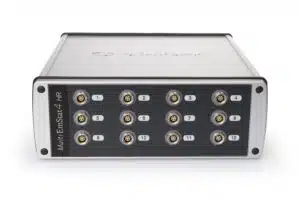 |
|
|
|
|
|
| Potential range | ±3 V | ±6 V |
| Max. compliance voltage
The compliance voltage is the maximum voltage that can be applied between the working and counter electrode. Another name could be the maximum cell potential. Continue reading
|
±5 V | ±8 V |
| Current ranges | 1 nA to 10 mA (8 ranges) | 100 nA to 100 mA (7 ranges) |
| Max. current | ±30 mA | ±200 mA |
| Electrode connections | WE, RE, CE and ground, 2 mm banana plugs |
WE, RE, CE, Sense, and ground, 2 mm banana plugs |
| Hardware options |
|
|
| General | ||
|---|---|---|
| LR | HR | |
dc-potential range
The maximum potential difference, that can be applied between WE and RE.
|
±3 V | ±6 V |
compliance voltage
The compliance voltage is the maximum voltage that can be applied between the working and counter electrode. Another name could be the maximum cell potential. Continue reading
|
±5 V | ±8 V |
| maximum current | ±30 mA | ±200 mA |
| max. data acquisition rate | 1 000 000 samples /s | |
| Potentiostat | ||
|---|---|---|
| LR | HR | |
| applied potential resolution | 100 µV | 183 µV |
applied potential accuracy
The applied potential accuracy describes how close to the real values your applied potential is.
|
≤ 0.2% ±1 mV offset | |
current ranges
A potentiostat measures current. For optimal precision, the range between which currents are measured is split into multiple current ranges. A current range defines the maximum current a potentiostat can measure in a certain range. This means it will also determine the resolution, because the number of bits or rather states is fixed, while the current range is variable.
|
1 nA to 10 mA 8 ranges |
100 nA to 100 mA 7 ranges |
measured current resolution
The lowest observable difference between two values that a measurement device can differentiate between.
|
0.009% of CR (92 fA on 1 nA range) | 0.009% of CR (9.2 pA on 100 nA range) |
| measured current accuracy
The current accuracy describes how close to the real values your measured current is.
|
< 0.2% of current ±20 pA ±0.2% of range |
< 0.2% of current ±0.2% of range |
bandwidth settings
The range of frequencies between which you can measure. Continue reading
|
320 Hz, 3.2 kHz, 30 kHz or 570 kHz | |
| Galvanostat | ||
|---|---|---|
| LR | HR | |
current ranges
A potentiostat measures current. For optimal precision, the range between which currents are measured is split into multiple current ranges. A current range defines the maximum current a potentiostat can measure in a certain range. This means it will also determine the resolution, because the number of bits or rather states is fixed, while the current range is variable.
|
10 nA, 1 uA, 100 uA, 10 mA 4 ranges |
1 uA, 100 uA, 10 mA, 100 mA 4 ranges |
| applied dc-current | ±3 * CR (current range) | |
| applied dc-current resolution | 0.01% of CR | 0.0183% of CR |
| applied dc- current accuracy
The current accuracy describes how close to the real values your measured current is.
|
< 0.4% of current ±20 pA ±0.2% of range |
< 0.4% of current ±0.2% of range |
| potential ranges |
50 mV, 100 mV, 200 mV, 500 mV, 1 V |
|
| measured dc-potential resolution |
96 µV at ±3 V (1 V range) |
193 µV at ±6 V (1 V range) |
| measured dc-potential accuracy | ≤ 0.2% ±1 mV offset | |
bandwidth settings
The range of frequencies between which you can measure. Continue reading
|
320 Hz, 3.2 kHz, 30 kHz or 570 kHz | |
| FRA / EIS | ||
|---|---|---|
| LR | HR | |
| frequency range | 10 µHz to 200 kHz | |
| ac-amplitude range |
1 mV to 900 mV rms, or 2.5 V p-p |
|
| measured current accuracy
The current accuracy describes how close to the real values your measured current is.
|
≤ 0.2% at Full Scale Range | |
| GEIS | ||
|---|---|---|
| LR | HR | |
| frequency range | 10 µHz to 200 kHz | |
| ac-amplitude range |
0.9 * CR (Arms) |
|
| Electrometer | ||
|---|---|---|
| LR | HR | |
electrometer amplifier input
The amplifier input resistance of the amplifier in the electrometer determines the load that the amplifier places on the source of the signal being fed into it. Ideally the resistance is infinite, and the load to be zero to not to influence your measurement.
|
> 1 TΩ // 10 pF | |
bandwidth
The range of frequencies between which you can measure. Continue reading
|
10 kHz default or 500 kHz for EIS and fast CA/CP |
|
| Other | ||
|---|---|---|
| LR | HR | |
| electrode connections |
WE, RE, CE, |
WE, RE, CE, S |
| housing |
aluminum body: |
|
| weight |
± 3 kg |
|
| power + communication |
USB (type B) port |
|
| internal storage space per channel |
500 MB, equivalent to > 15M datapoints |
|
| MultiEmStat4 LR EIS Accuracy Contour Plot |
|---|
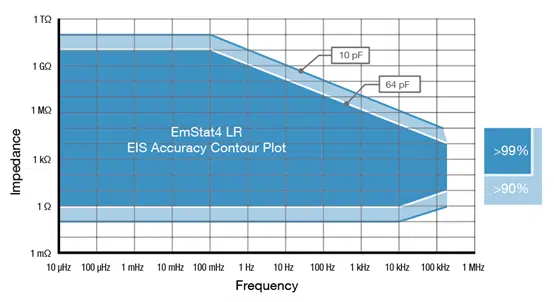 |
| MultiEmStat4 HR EIS Accuracy Contour Plot |
|---|
 |
Software
MultiTrace for Windows
The MultiTrace software gives you full control over the channels of our multi-channel instruments. MultiTrace can be used with multi-channel potentiostats in two different modes; the Individual and Simultaneous mode.
Individual mode
All potentiostats are used independently. Measurements can be started on all channels with one click, or one at a time on individual channels. Each measured curve is shown in its own plot.
Simultaneous mode
All channels run the same measurement at the same time (optionally hardware-synchronized). The measured curves are displayed in a single plot and can be stored together in a single data file or in separate data files.
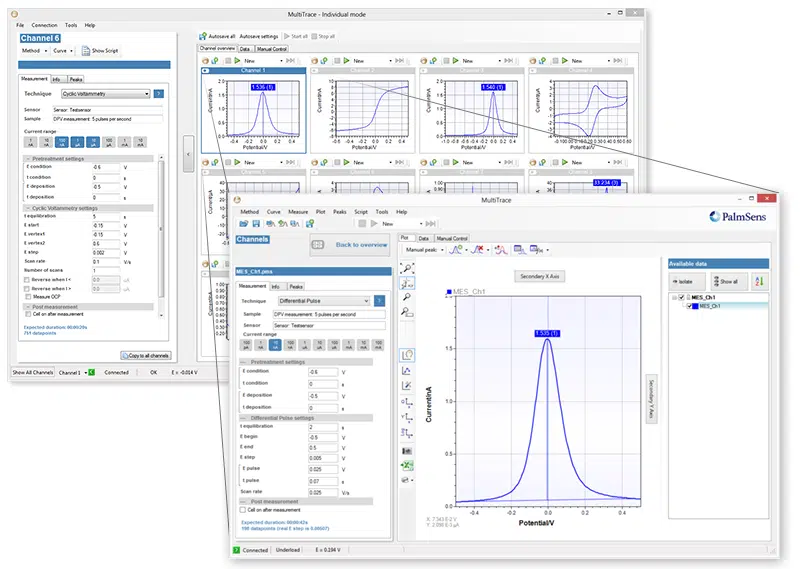
Software Development Kits
The PalmSens Software Development Kits (SDKs) for .NET can be used with any of our instruments or OEM potentiostat modules to develop your own software. The SDK’s come with a set of examples that shows how to use the libraries.
PalmSens SDKs with examples are available for the following .NET Frameworks:
- WinForms
- WPF
- Xamarin (for Android)

Downloads
Software (2)
| Name | Last updated | |
|---|---|---|
|
MethodSCRIPT code examples
MethodSCRIPT code examples include:
- MethodSCRIPTExample_C - MethodSCRIPTExample_C_Linux - MethodSCRIPTExample_C# - MethodSCRIPTExample_Arduino - MethodSCRIPTExample_Python - MethodSCRIPTExample_iOS - MethodSCRIPTExample_Android Every code example comes with a "Getting Started" document. |
07-07-24 | |
| MultiTrace – PC Software for all Multi-channel instruments The MultiTrace software controls the individual channels of our multi-channel instruments. You can also combine multiple single-channel instruments. | 17-03-22 |
Documentation (5)
| Name | Last updated | |
|---|---|---|
| MultiEmStat4 Brochure MultiEmStat4 Brochure, a Multi-Channel Potentiostat, Galvanostat and Impedance Analyzer. | 25-04-24 | |
| MethodSCRIPT v1.5 The MethodSCRIPT scripting language is designed to improve the flexibility of the PalmSens potentiostat and galvanostat devices for OEM users. It allows users to start measurements with arguments that are similar to the arguments in PSTrace. PalmSens provides libraries and examples for handling low level communication and generating scripts for MethodSCRIPT devices such as the EmStat Pico and EmStat4. | 25-03-24 | |
| EmStat4M Communication Protocol V1.3 Describes how to communicate with the EmStat4M directly and how to send MethodSCRIPTS. | 25-03-24 | |
| EmStat4M Communication Protocol V1.2 Describes how to communicate with the EmStat4M directly and how to send MethodSCRIPTS. | 01-02-23 | |
| MethodSCRIPT v1.4 The MethodSCRIPT scripting language is designed to improve the flexibility of the PalmSens potentiostat and galvanostat devices for OEM users. It allows users to start measurements with arguments that are similar to the arguments in PSTrace. PalmSens provides libraries and examples for handling low level communication and generating scripts for MethodSCRIPT devices such as the EmStat Pico and EmStat4. | 01-02-23 |
Application Note (1)
| Name | Last updated | |
|---|---|---|
| Multi-Channel: Multiple Working Electrodes in the Same Cell Learn how to use a multi-channel potentiostat as a polypotentiostat, so you can use multiple working electrodes in the same cell sharing one reference and counter electrode. | 19-01-22 |



























